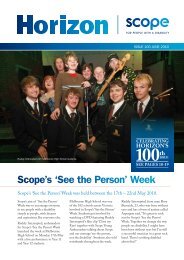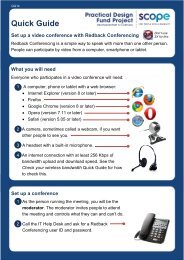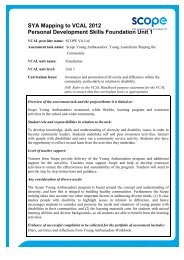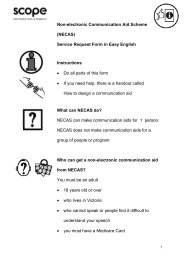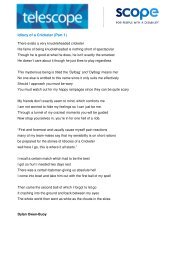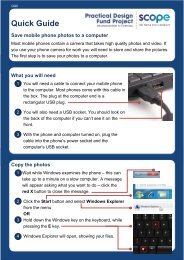Positive behaviour support Getting it right from the start
Positive behaviour support Getting it right from the start
Positive behaviour support Getting it right from the start
You also want an ePaper? Increase the reach of your titles
YUMPU automatically turns print PDFs into web optimized ePapers that Google loves.
<strong>Pos<strong>it</strong>ive</strong> <strong>behaviour</strong> <strong>support</strong>: <strong>Getting</strong> <strong>it</strong> <strong>right</strong> <strong>from</strong> <strong>the</strong> <strong>start</strong> - Facil<strong>it</strong>ators reference manual 49<br />
up – Unintentional passive communication<br />
The communication of adolescents or adults who are assessed as being at stages 1 or 2 may<br />
seem qu<strong>it</strong>e passive. There may be physical or sensory problems that affect <strong>the</strong> person’s abil<strong>it</strong>y<br />
to be involved in some events or activ<strong>it</strong>ies. Health issues may impact on <strong>the</strong>ir qual<strong>it</strong>y of life. All<br />
interactions are based on <strong>the</strong> communication partner’s awareness of <strong>the</strong> person’s needs and<br />
observations of <strong>the</strong> person’s <strong>behaviour</strong>. (InterAACtion page 21)<br />
ua – Unintentional active communication<br />
Some people who communicate unintentionally are more active than o<strong>the</strong>rs. They are much<br />
more likely to reach out for things that attract <strong>the</strong>ir attention and interest. If <strong>the</strong>y are able to<br />
physically, <strong>the</strong>y may walk. All interactions are based on <strong>the</strong> communication partner’s awareness<br />
of <strong>the</strong> person’s needs and observations of <strong>the</strong>ir <strong>behaviour</strong>. (InterAACtion page 35)<br />
ii – Intentional informal communication<br />
The person at <strong>the</strong> intentional informal stage of communication knows that o<strong>the</strong>r people<br />
can be useful. The person understands that for communication to occur, <strong>the</strong> attention of a<br />
communication partner is required. (InterAACtion page 55)<br />
sb – Symbolic (basic) communication<br />
A person is able to communicate symbolically when <strong>the</strong>y understand what words, pictures,<br />
or signs can be used to communicate about a real object or events. The person is also able<br />
to communicate a range of intentions or functions through pictures, gestures, single words or<br />
vocalisations. (InterAACtion page 73)<br />
se – Symbolic (established) communication<br />
By this stage <strong>the</strong> person is communicating at an established symbolic level. They can recognise<br />
a large number of pictures, photos and line drawings and are more likely to use <strong>the</strong>se to in<strong>it</strong>iate<br />
interactions w<strong>it</strong>h familiar people. Photos, pictures and line drawings may also be incorporated<br />
into a range of different communication aids including electronic communication devices,<br />
boards, books and wallets. The person may put signs, pictures or words toge<strong>the</strong>r to make simple<br />
two-word phrases. The person may use <strong>the</strong>ir communication skills to comment, chat, request or<br />
reject something. They also have a reliable way of indicating yes and no to simple questions. If<br />
something is missing, <strong>the</strong>y may seek help <strong>from</strong> o<strong>the</strong>rs or try to remember where <strong>the</strong>y last saw <strong>it</strong>.<br />
(InterAACtion page 89)<br />
Alternative and augmentative communication<br />
Some people find communication difficult because <strong>the</strong>y have l<strong>it</strong>tle or no clear speech. The idea<br />
behind AAC is to use <strong>the</strong> person’s abil<strong>it</strong>ies, whatever <strong>the</strong>y are, to compensate for <strong>the</strong>ir difficulties<br />
and to make communication as quick, simple and effective as is possible when speech alone<br />
does not work.<br />
Although we all use aspects of AAC <strong>from</strong> time to time ( e.g. waving goodbye instead of saying <strong>it</strong>,<br />
pointing to a picture or gesturing to make yourself understood in a foreign country) some people<br />
may rely on ACC all of <strong>the</strong> time.<br />
Augmentative communication refers to any approach designed to <strong>support</strong> or enhance <strong>the</strong><br />
communication of individuals who have speech skills which are lim<strong>it</strong>ed or ineffective.<br />
Alternative communication refers to communication systems for people w<strong>it</strong>h no oral<br />
communication skills whatsoever.



